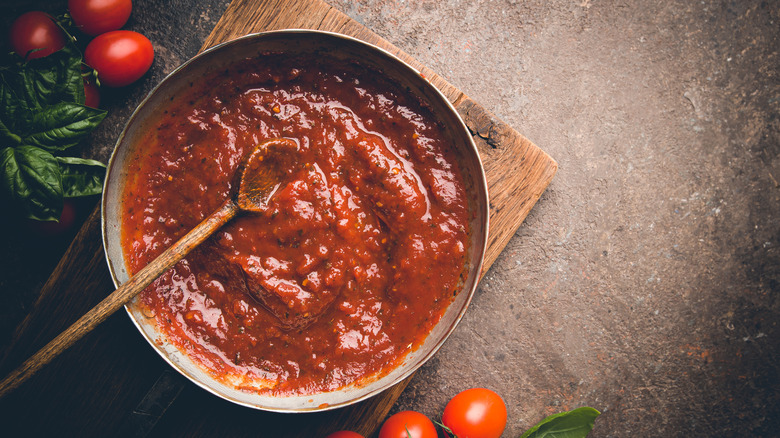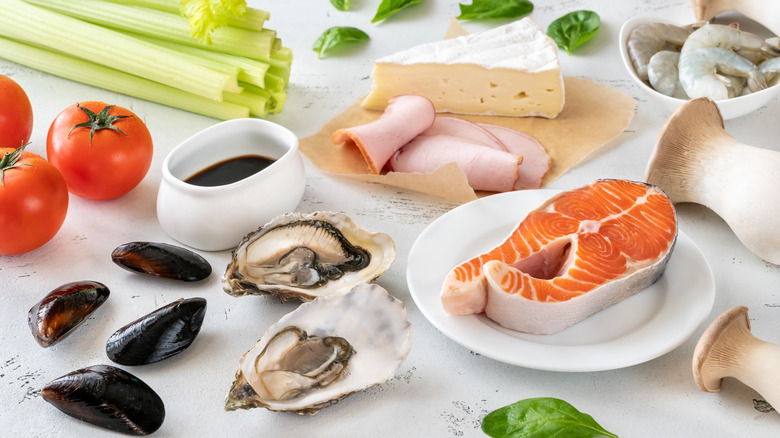The Umami-Filled Ingredients That Will Easily Boost Your Tomato Sauce
Making your own tomato sauce is a great cooking practice that will not only elevate your standard pasta dinner, but can be a great way to use up an abundant summer tomato harvest as well. The key to making a great tomato sauce starts with quality ingredients, but also by finding a balance between the sweet acidity of cooked tomatoes. Southern Living claims that the best way to counter these overwhelming elements is to add a punch of savory umami flavors to your sauce.
There are tons of different ways to add the mysterious element of umami to your sauce. It really just comes down to personal preference, and maybe what you already have in your pantry. Adding tomato paste is one of the simplest ways to add a punch of umami. It already has that condensed tomato flavor, and more of the elements that savory taste receptors respond to. There's no need to stop there though. If you want to add other tastes or elements to your sauce you can do so easily with anything from Worcestershire sauce, soy sauce, tamari, fish sauce, or anchovy paste. The key to understanding these flavors first comes from understanding umami itself.
What is umami?
Umami is a flavor that is much more than the salty or savory notes that it is often compared to. This mysterious "fifth flavor" was actually only discovered fairly recently. It was first discovered by the Japanese researcher Kikunae Ikeda in 1908. He was the first person to isolate monosodium glutamate (MSG), and identify glutamate, inosinate, and guanylate among other compounds as the sources of the fifth primary taste.
It's hard to describe, so it is often paired with salty or savory because they conjure up similar flavors of roasted meats. Umami is a Japanese word that can be translated to "tastiness" or "deliciousness." It's hard to pin down the exact flavor notes that comprise this taste because they are so much more than other categories. Sweetness is embodied by sugar or honey, but once sugar becomes caramel it starts to take on the savory, deep flavors of umami in addition to those sweets. This is a highly common flavor found in roasted meats, aged cheeses, fish, dried mushrooms, and seaweeds. Additionally, it is very common among fermented foods as well.
However, no matter which source is providing these tastes, it is an essential element of dining that should be represented in the best dishes. All it takes is one of the many umami powerhouse ingredients to give your tomato sauce a serious upgrade.
Best ways to add umami to tomato sauce
Tomato paste is the most subtle way to add umami to a tomato sauce, but there are so many other great options out there. Soy sauce is definitely one of the best "umami bombs" that most home cooks have available. We love it for everything from spiking up the meaty flavor in bolognese or chili, but it can be used as a "secret ingredient" any time you want to add notes of umami to a dish. If you get to know different soy sauce varieties as well you can have even more control over your tomato sauce. For example, light soy sauces are great for adding that signature flavor without altering a food's color as much as a dark soy sauce would.
Ingredients that use roasted fish like fish anchovy paste or fish sauce are also great for adding a ton of those umami compounds. Just remember to give them some time to cook in the sauce in order to allow for most of the overpowering "fishy" notes to mellow out and leave only umami behind.
Other fermented foods and sauces like miso or tamari are also good for tomato sauces. Tamari is a brew that is similar to soy sauce that relies on fermented soy for its deep flavor. This gives it a lighter color and adds umami with hints of salt, and sweetness as well.


